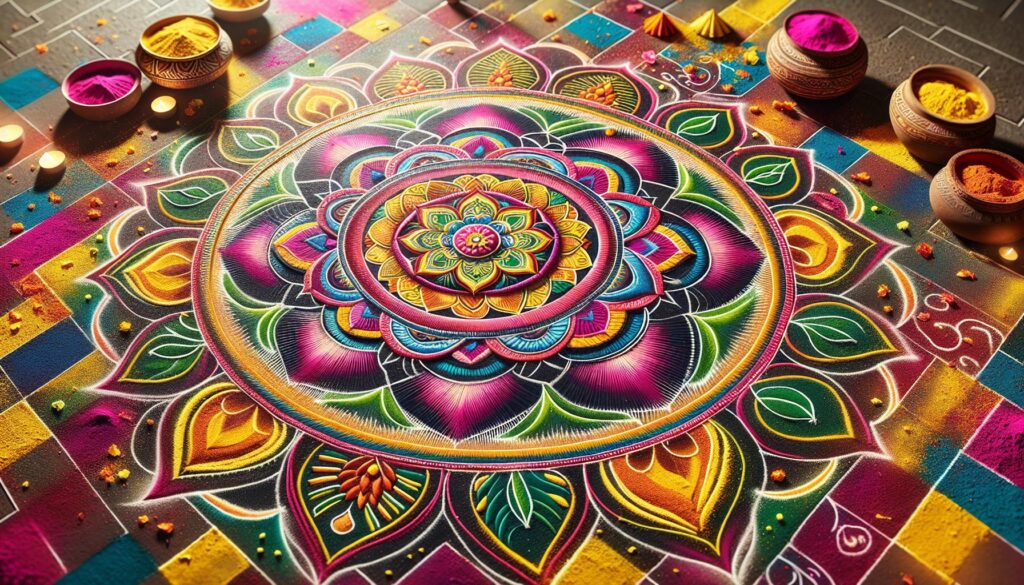I’ve always been fascinated by the vibrant art of rangoli, a traditional Indian practice of creating stunning patterns using colored powder, rice flour, or chalk. These beautiful floor decorations aren’t just visually appealing – they’re also deeply rooted in cultural significance and bring joy during festivals and special occasions.
While beautiful:ma8xead5pgg= easy rangoli designs might seem intimidating at first, I’ll show you that creating beautiful patterns doesn’t have to be complicated. Whether you’re a beginner or someone looking to explore this art form, there are plenty of easy rangoli designs that can transform your space into a colorful masterpiece. With just a few simple tools and basic geometric shapes as your foundation, you’ll be surprised at how quickly you can master this beautiful art form.
Key Takeaways
- Rangoli is a traditional Indian art form that uses colored powder, rice flour, or chalk to create vibrant floor decorations with deep cultural significance.
- Basic geometric shapes like circles, squares, and triangles serve as the foundation for creating simple yet beautiful rangoli patterns, making it accessible for beginners.
- Essential materials include rangoli powder, stencils, measuring tools, and application equipment like funnels and sifters, with costs ranging from $5 to $25 for basic supplies.
- Traditional rangoli patterns incorporate religious symbols and nature-inspired motifs, each carrying specific cultural meanings and used during different festivals and occasions.
- Modern interpretations include digital rangoli apps, LED-enhanced designs, and mixed-media approaches, allowing for contemporary expressions while preserving cultural traditions.
Beautiful:ma8xead5pgg= Easy Rangoli
Rangoli art transforms floors into vibrant canvases using colored powder rice flour sand chalk or flower petals. The word “”rangoli”” originates from Sanskrit “”rangavalli”” meaning rows of colors.
Traditional rangoli patterns include:
- Geometric shapes like circles squares triangles combined in symmetrical designs
- Nature-inspired motifs featuring flowers peacocks elephants lotus patterns
- Abstract patterns incorporating swirls curves dots interconnected lines
- Religious symbols such as Om swastika lotus diyas footprints
Key characteristics of rangoli include:
- Created on flat surfaces typically at entrances courtyards prayer spaces
- Uses natural eco-friendly materials that are easy to clean
- Features balanced proportions radiating from a central point
- Incorporates symbolic elements representing prosperity luck abundance
Materials commonly used:
- Dry colored powders (rangoli colors)
- Rice flour mixed with water
- Flower petals seeds
- Colored sand chalk
- Natural dyes kumkum turmeric
| Rangoli Type | Primary Materials | Durability |
|---|---|---|
| Powder | Colored rangoli powder | 1-2 days |
| Wet | Rice flour paste | 3-4 days |
| Floral | Fresh petals seeds | 1 day |
| Sand | Colored sand | 5-7 days |
Each beautiful:ma8xead5pgg= easy rangoli design carries specific cultural meanings dependent on festivals occasions regional traditions. The art form plays an essential role in Hindu customs marking auspicious events celebrations welcoming deities guests into homes.
Traditional Rangoli Patterns and Their Significance
Traditional rangoli patterns incorporate geometric precision with cultural symbolism, creating designs passed down through generations. These patterns serve as visual prayers welcoming deities while bringing prosperity to households.
Common Geometric Shapes
Geometric shapes form the foundation of traditional rangoli designs:
- Dots connect in straight lines to create symmetrical star patterns using 4-8 points
- Concentric circles represent the cyclical nature of life using equidistant spacing
- Interlocking squares transform into complex mandalas through diagonal connections
- Triangular patterns symbolize mountains with upward-pointing vertices
- Hexagonal designs feature six-fold symmetry mimicking natural crystalline forms
- Linear borders frame designs using parallel lines spaced 1-2 inches apart
- Spiral patterns flow from center points in clockwise rotation
- Swastika marks auspicious beginnings in square or circular frames
- Lotus flowers emerge from central points with 8-16 symmetrical petals
- Deepak (lamp) motifs include flame shapes pointing upward
- Om symbols incorporate curved lines with decorative flourishes
- Peacock patterns feature elongated tail feathers in arc formations
- Divine footprints (pada) align toward temple entrances
- Conch shell designs spiral inward from wide openings
- Sacred plants like tulsi leaves arrange in repeating patterns
- Elephant motifs display raised trunks symbolizing good fortune
| Symbol | Traditional Meaning | Common Festival Usage |
|---|---|---|
| Lotus | Divine purity | Diwali, Pongal |
| Swastika | Good fortune | New Year, Housewarmings |
| Peacock | Divine beauty | Krishna Janmashtami |
| Om | Universal consciousness | Daily worship |
| Deepak | Divine light | Evening ceremonies |
Essential Materials for Making Rangoli
Creating rangoli requires specific materials that enhance the visual appeal while ensuring smooth application. I’ve compiled a comprehensive list of essential items needed for crafting beautiful rangoli designs.
Color Powder Options
Traditional rangoli powder (rangoli colors) comes in vibrant shades including red, yellow, green, blue white. These specialized powders provide optimal flow control for precise pattern creation. Alternative color materials include:
- Dry Pigments: Natural stone-ground colors with fine consistency
- Gulal Powder: Festival-grade colors with superior spreading properties
- Rice Flour: White base material mixed with natural food coloring
- Chalk Powder: Cost-effective option available in multiple colors
- Organic Powders: Turmeric, kumkum vermillion red henna green
| Material Type | Durability | Cost Range (USD) | Available Colors |
|---|---|---|---|
| Rangoli Colors | 3-4 days | $15-25/set | 12-15 shades |
| Gulal Powder | 1-2 days | $8-12/set | 8-10 shades |
| Rice Flour Mix | 1 day | $5-8/kg | Custom mixed |
- Metal Funnels: 3-5 sizes for controlled powder flow
- Pattern Stencils: Basic geometric shapes circle square triangle
- Measuring Tools: Ruler compass protractor
- Surface Preparation: Flat brush broom cleaning cloth
- Application Tools:
- Fine-tipped bottles
- Powder sifters
- Pattern markers
- Small spoons
- Protection Items:
- Disposable gloves
- Face mask
- Application mat
Step-by-Step Easy Rangoli Designs
Creating beautiful:ma8xead5pgg= easy rangoli designs starts with understanding simple geometric patterns and shapes. I’ve developed these beginner-friendly patterns that use minimal tools and materials while producing stunning results.
Basic Flower Pattern
- Draw a small circle in the center using chalk or rice flour
- Create 8 equidistant dots around the circle at 2-inch intervals
- Connect these dots with curved lines to form petals
- Add smaller circles between each petal
- Fill the petals with contrasting colors like red yellow orange
- Enhance the center with a bright focal color
- Add dots along petal edges for definition
- Mark 4 equal points in a square formation
- Connect points with straight lines to create the border frame
- Add small triangles at regular intervals along the border
- Create a zigzag pattern inside the main border lines
- Fill alternate sections with complementary colors
- Place dots at triangle peaks for added detail
- Add small curved lines between triangles
| Item | Basic Flower | Border Design |
|---|---|---|
| Colors | 3-4 shades | 2-3 shades |
| Time | 15 minutes | 20 minutes |
| Space | 12 inches | 18 inches |
| Tools | Funnel sieve | Ruler chalk |
Tips for Creating Perfect Rangoli
Planning and Preparation
I recommend organizing materials in separate containers before starting beautiful:ma8xead5pgg= easy rangoli work. Place colors in small bowls based on design elements: darker shades for outlines, brighter hues for filling patterns. Create a makeshift workspace by clearing a 4×4 foot area, sweeping it thoroughly to remove debris.
Design Selection and Sketching
I create a basic sketch on paper first, marking key points for geometric patterns. For beginners, starting with 4-8 symmetrical points works best. Breaking down complex designs into simple shapes – circles, squares, triangles – makes execution easier.
Surface Preparation
The surface texture impacts rangoli quality. I smooth rough floors with a dry cloth, remove moisture with talcum powder, apply a thin base layer of white powder to create contrast.
Color Application Techniques
- Pour powder in thin streams using controlled hand movements
- Start from the center, moving outward for symmetrical patterns
- Apply darker colors first, then fill with lighter shades
- Use metal funnels for precise line work
- Layer colors gradually to prevent mixing
Common Mistakes to Avoid
- Uneven powder distribution creates patchy designs
- Crossed lines blur pattern boundaries
- Excessive powder causes smudging
- Working without guide points leads to asymmetry
- Rushing through detailed sections reduces precision
Maintenance During Creation
- Small brushes for cleanup
- Cotton swabs for fixing edges
- Paper strips as barriers between colors
- Spoons for precise powder placement
- Cloth pieces for wiping spills
| Weather Condition | Precaution |
|---|---|
| Windy | Create barriers around workspace |
| Humid | Add rice flour to powder mix |
| Hot | Keep colors in shade |
| Rainy | Work in covered area |
Modern Interpretations of Rangoli Art
Contemporary artists redefine traditional rangoli through innovative materials, techniques, and design elements. Digital rangoli platforms enable artists to create virtual designs using tablets and digital pens. Mixed-media rangoli incorporates non-traditional elements like crystals, mirrors and LED lights.
Digital Rangoli Innovations
Digital rangoli apps transform traditional floor art into interactive experiences through:
- Touch-screen drawing capabilities for precise pattern creation
- Pre-loaded traditional designs with customization options
- Color palette libraries featuring over 1000 shades
- Social sharing features to connect global rangoli communities
- Virtual reality experiences for 3D rangoli visualization
Fusion Materials and Techniques
Modern rangoli artists experiment with unconventional materials:
- Metallic powders mixed with traditional colors for shimmer effects
- UV-reactive pigments creating glow-in-dark patterns
- Biodegradable glitter made from plant-based materials
- Recycled glass pieces for mosaic-style designs
- Water-resistant polymers for outdoor installations
- Abstract geometric compositions using 3D elements
- Optical illusion patterns creating depth perception
- Pop culture references integrated into classical designs
- Minimalist interpretations of traditional symbols
- Large-scale installations spanning multiple rooms
| Modern Rangoli Style | Average Creation Time | Material Cost Range |
|---|---|---|
| Digital Rangoli | 30-60 minutes | $0-20 (app costs) |
| LED-Enhanced | 2-3 hours | $50-150 |
| Mixed Media | 3-4 hours | $75-200 |
| UV-Reactive | 2-3 hours | $40-100 |
| Large-scale Installation | 5-8 hours | $200-500 |
Practice Makes Perfect
Creating beautiful:ma8xead5pgg= easy rangoli doesn’t have to be complicated. I’ve shared how this ancient art form can be adapted to suit modern preferences while maintaining its cultural essence. Whether you’re using traditional materials or exploring digital alternatives there’s a rangoli style that’ll work for you.
I encourage you to start with simple patterns and gradually work your way up to more intricate designs. Remember that every rangoli artist started as a beginner and practice makes perfect. The joy of creating these colorful patterns and participating in this rich cultural tradition is truly rewarding.
Let your creativity flow and don’t be afraid to experiment with different materials and designs. Your rangoli journey is unique and there’s no right or wrong way to express yourself through this vibrant art form.

